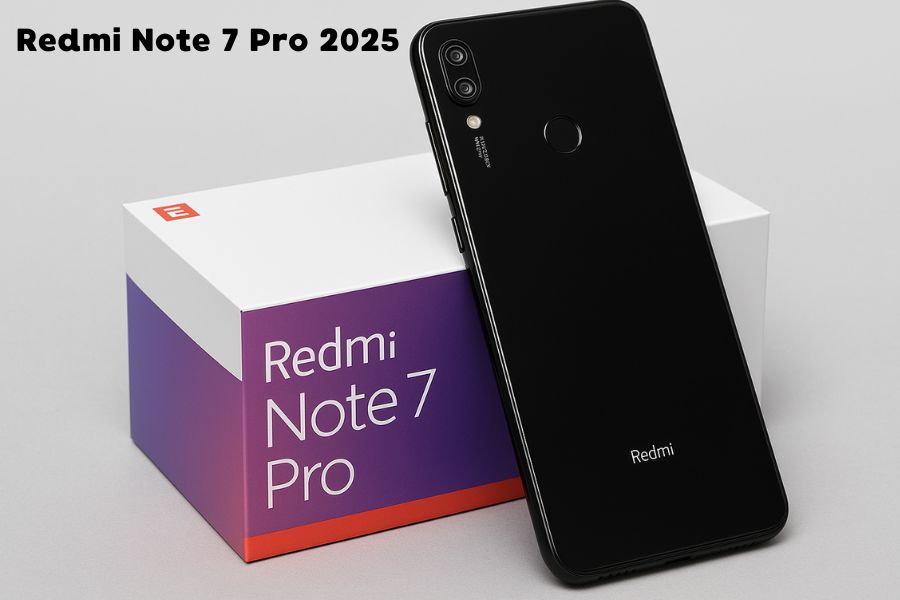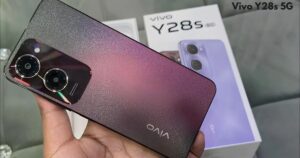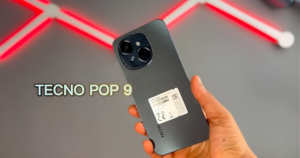Redmi Note 7 Pro 2025 : The Smartphone That Redefined Budget Performance
Redmi Note 7 Pro 2025: The smartphone industry is continuously evolving, and every now and then, a device emerges that completely shifts the market dynamics. In early 2019, Xiaomi introduced one such game-changing device: the Redmi Note 7 Pro. As part of its hugely successful Redmi Note series, the Note 7 Pro pushed the boundaries of what consumers could expect from a budget-friendly smartphone. Featuring powerful internals, a premium glass design, and an impressive 48MP camera, the Redmi Note 7 Pro quickly became a fan favorite and set a new benchmark for mid-range phones in India and other markets.
Redmi Note 7 Pro 2025 : A Bold New Design
One of the first things that made the Redmi Note 7 Pro stand out was its design. Xiaomi took a bold step by moving away from the metallic builds of its predecessors and embraced a more premium glass sandwich design. The phone featured Corning Gorilla Glass 5 on both the front and back, providing durability and a premium in-hand feel. The glossy, reflective finish and gradient colors gave it an appearance similar to high-end flagship devices. The phone was available in striking colors like Neptune Blue, Nebula Red, and Space Black, each with a unique visual appeal that made the device look far more expensive than it actually was.
The build quality was commendable. Despite being a budget smartphone, it felt sturdy and well-constructed. Xiaomi also included a P2i nano-coating for splash resistance, which added a layer of protection against accidental water exposure. The device had a rear-mounted fingerprint sensor and a dual-camera module, while the front featured a waterdrop-style notch for housing the selfie camera.
Redmi Note 7 Pro 2025 : Display Quality That Delivers
The Redmi Note 7 Pro came with a 6.3-inch Full HD+ IPS LCD display, offering a resolution of 2340 x 1080 pixels and a 19.5:9 aspect ratio. The display was vibrant and sharp, with excellent color reproduction and good viewing angles. The notch at the top was unobtrusive, allowing for an immersive viewing experience whether you were watching YouTube videos, playing games, or browsing social media.
With a pixel density of around 409 PPI, the display offered excellent clarity, making text look sharp and images highly detailed. The brightness levels were also decent for outdoor usage, though direct sunlight readability was average. Xiaomi also included software features like Reading Mode and Night Mode to enhance usability and reduce eye strain during extended usage.
Redmi Note 7 Pro 2025 : Groundbreaking 48MP Camera
Perhaps the most advertised and widely praised feature of the Redmi Note 7 Pro was its camera. It was one of the first smartphones in its price segment to offer a 48MP primary sensor, a significant leap in camera technology at the time. The primary rear camera used Sony’s IMX586 sensor, paired with an f/1.79 aperture and a secondary 5MP depth sensor for portrait shots.
In daylight conditions, the camera performed exceptionally well, capturing images with great detail and accurate colors. The high-resolution sensor allowed for excellent sharpness and the ability to crop images without losing much detail. In default settings, the phone used pixel binning to combine four pixels into one, effectively producing 12MP images that were brighter and less noisy, especially in low-light conditions.
The dedicated Night Mode was also impressive for the time, capturing brighter and clearer shots in dim environments. Portrait mode offered good edge detection and natural-looking bokeh effects. The 13MP front-facing camera also delivered sharp and vibrant selfies, with AI-powered beautification features that appealed to many users.
Redmi Note 7 Pro 2025 : Performance Powered by Snapdragon 675
Under the hood, the Redmi Note 7 Pro was powered by the Qualcomm Snapdragon 675 chipset, which was based on an 11nm process and offered a balanced mix of performance and efficiency. This octa-core processor was paired with either 4GB or 6GB of RAM and 64GB or 128GB of internal storage, depending on the variant.
In real-world usage, the phone handled day-to-day tasks smoothly, including web browsing, social media, messaging, and multitasking. The Adreno 612 GPU handled gaming quite well for its class, with popular titles like PUBG Mobile and Asphalt 9 running smoothly on medium to high settings. Thermal management was efficient, and the phone remained cool during extended gaming sessions.
The combination of the Snapdragon 675 and MIUI optimization provided a fluid user experience, making the Redmi Note 7 Pro a reliable performer in the mid-range segment. Benchmark scores at the time placed it ahead of many of its competitors, solidifying its reputation as a powerhouse in its category.
Redmi Note 7 Pro 2025 : MIUI and Software Features
The Redmi Note 7 Pro initially shipped with MIUI 10 based on Android 9 Pie and received updates over time. MIUI offered a highly customizable interface with numerous features and themes, allowing users to personalize their device extensively. While MIUI was not stock Android and had its share of ads and bloatware, Xiaomi allowed users to disable most of the unwanted elements.
Some of the standout software features included Dual Apps, Second Space, App Lock, and full-screen gesture navigation. MIUI also provided in-depth battery and performance management tools, helping users optimize their experience. Regular updates and a large community support base ensured that the phone remained relevant even years after its launch.
Redmi Note 7 Pro 2025 : Battery Life and Charging
The Redmi Note 7 Pro packed a 4000mAh battery, which was more than sufficient for a full day of heavy usage. Whether you were streaming videos, gaming, or multitasking, the phone consistently delivered excellent battery life. Many users reported getting over a day’s usage with ease, and light users could stretch it to nearly two days on a single charge.
The phone supported Qualcomm Quick Charge 4.0, though Xiaomi only included a 10W charger in the box. With a compatible fast charger, users could take advantage of significantly faster charging times. A full charge with the standard charger took around 2 hours, while a Quick Charge 4.0 charger reduced that time considerably. The USB Type-C port was a welcome addition, as many budget phones still shipped with micro USB at that time.
Redmi Note 7 Pro 2025 : Storage and Expandability
The phone came in two main variants: 4GB RAM + 64GB storage and 6GB RAM + 128GB storage. Both versions used UFS 2.1 storage, which was faster than the eMMC storage found in many competitors. This led to quicker app loading times and smoother overall performance.
The Redmi Note 7 Pro also supported microSD cards for storage expansion, though it featured a hybrid SIM slot. This meant users had to choose between using two SIM cards or one SIM and one microSD card. While not ideal for everyone, the generous internal storage in the higher-end variant made this a non-issue for many users.
Redmi Note 7 Pro 2025 : Audio and Multimedia
The Redmi Note 7 Pro offered a decent multimedia experience. The bottom-firing mono speaker was loud and clear, making it suitable for media consumption, though stereo output was absent. The 3.5mm headphone jack was present, which was appreciated by many users, especially audiophiles.
Xiaomi also included support for Hi-Fi audio and enabled customizable audio profiles via the MIUI settings, providing a richer listening experience with compatible headphones. The inclusion of FM radio and IR blaster added more utility to the phone, making it a well-rounded multimedia device.
Redmi Note 7 Pro 2025 : Connectivity and Network Support
Connectivity options on the Redmi Note 7 Pro included 4G VoLTE, Wi-Fi 802.11ac, Bluetooth 5.0, GPS, USB Type-C, and a 3.5mm headphone jack. The phone performed well in terms of call quality and network reception. It also supported dual SIM usage with VoLTE on both slots, ensuring users could take advantage of HD calling across networks.
The inclusion of Bluetooth 5.0 allowed for faster pairing and better connection stability with wireless devices. GPS performance was accurate, making it reliable for navigation and location-based services.
Redmi Note 7 Pro 2025 : Durability and Protection
Xiaomi emphasized durability in the Redmi Note 7 Pro by equipping it with Gorilla Glass 5 on both sides, which offered better resistance to scratches and minor drops. While not entirely shatterproof, the phone held up better than many other devices in the same price range.
The P2i nano-coating made the device resistant to splashes and light rain, though it wasn’t fully waterproof. This small addition added peace of mind for users and contributed to the device’s overall robustness. The phone also came with a basic silicone case in the box, providing immediate protection for first-time users.
Redmi Note 7 Pro 2025 : Market Impact and Consumer Response
Upon its launch, the Redmi Note 7 Pro received overwhelming positive feedback from both critics and consumers. It consistently topped sales charts, particularly in India, where it was sold out within minutes of flash sales. Xiaomi’s strategy of offering high-end features at aggressive pricing paid off, as the device became one of the best-selling smartphones of its time.
Reviewers praised the phone for its powerful performance, excellent camera, premium design, and great battery life. It also garnered attention internationally, making Xiaomi a more prominent player in markets outside China and India. The Note 7 Pro raised the expectations for budget smartphones and forced other manufacturers to step up their offerings in order to stay competitive.
Redmi Note 7 Pro 2025 : Longevity and Continued Relevance
Even years after its launch, the Redmi Note 7 Pro remains in use by a significant number of users. Xiaomi’s commitment to providing updates and the strong hardware foundation of the device ensured it aged well. Many users continued to use it as their primary phone due to its balanced performance and reliability.
The success of the Redmi Note 7 Pro laid the groundwork for future Redmi devices, such as the Note 8 Pro, Note 9 Pro, and beyond. It proved that budget devices didn’t have to compromise on essential features and could still offer a flagship-like experience at a fraction of the cost.
Conclusion
The Redmi Note 7 Pro was not just another smartphone in Xiaomi’s lineup—it was a game-changer. It redefined what consumers could expect from a mid-range phone and forced the entire industry to rethink pricing and feature offerings. With its powerful Snapdragon 675 processor, groundbreaking 48MP camera, solid build quality, and excellent battery life, it set new standards in the sub-Rs. 15,000 segment.
Even today, the Redmi Note 7 Pro is fondly remembered as a smartphone that offered unmatched value and innovation. It successfully blurred the lines between budget and premium, making high-end features accessible to the masses. For those who experienced it, the Note 7 Pro wasn’t just a phone—it was a revolution in their pocket.



